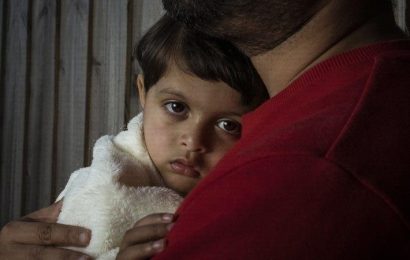ANOTHER massive winter storm is set to hammer parts of the US this weekend.
The wild weather is forecast to move across the country, before hitting the East Coast toward the end of the week, according to the Weather Channel.
The storm has also been named Winter Storm Miles.
The National Weather Service is warning that the central, southern, and eastern US will face a wintry mix of heavy snow and rain, resulting in possible flooding and thunderstorms.
It’s highly likely that snow will hit northern Texas to northern New England from Wednesday into Thursday, according to AccuWeather.
It comes after thousands of flights were canceled across the country earlier this month due to snow, and sleet hitting over 20 states.
More than 100million people were under winter weather alerts and at least 3,600 flights that were scheduled were axed, causing widespread travel disruption.
Read our Winter Storm Miles path tracker for the latest news and updates…
- Amanda Castro
Types of winter storms: Blizzards
Blizzards are extreme snowstorms that are distinguished by the force of the winds rather than the amount of snow they produce.
These storms cause blowing snow conditions, in which snow on the ground is scooped up by the wind, creating reduced visibility and the building of snowdrifts, when wind speeds reach or exceed 35 mph.
A blizzard lasts three or more hours and frequently results in large amounts of snow accumulation, either from new precipitation or through the redistribution of previously fallen snow as blowing snow.
- Amanda Castro
Types of winter storms: Snowstorms
A snowstorm is a storm in which the precipitation falls as snow.
Because the temperatures at the top of the storm are low enough to generate snowflakes, most precipitation falls as snow among the clouds in the winter.
The precipitation will fall as snow if the air temperature between the cloud and the ground remains at or below 0°C.
The precipitation will melt into rain or freezing rain if the air temperature near the ground is above freezing.
- Amanda Castro
How do winter storms form? continued
Precipitation will fall as snow or ice near the ground and up to the clouds due to air temperatures below freezing.
Extremely cold air, on the other hand, cannot store as much moisture and, as a result, does not produce as much snow.
This helps to explain why some of the world's coldest areas, such as Antarctica, receive relatively little precipitation year-round.
- Amanda Castro
How do winter storms form?
Like other forms of storms, winter storms begin with wet air ascending into the atmosphere.
At a cold front, rising air occurs when warm air is elevated above cold air, which is essential for cloud formation and precipitation.
As air flows up a huge hill or mountain, it may also rise. Clouds and precipitation cannot form without a source of moisture, such as air flowing across a huge lake or ocean.
The third component, and the one that distinguishes a winter storm from others, is cold air.
- Amanda Castro
Class cancellations on the rise, continued
In addition to the previous Alabama schools canceling classes due to the storm, the following are as well:
- Franklin County Schools: 12.30 pm dismissal Thursday
- Hale County Schools: 11.30 am dismissal Thursday
- Jasper City Schools: 12pm dismissal Thursday
- Lauderdale County Schools: Virtual learning Thursday
- Lamar County Schools: 12pm dismissal Thursday
- Muscle Shoals City Schools: 1pm dismissal Thursday
- Tuscumbia City Schools: 1pm dismissal Thursday
- Walker County Schools: Virtual learning Thursday
- Winston County Schools: Virtual learning Thursday
Class cancellations on the rise
With strong to severe storms expected across Alabama on Thursday, numerous school districts have announced closures, virtual learning, or early dismissals in advance of the storm.
For Thursday, February 17, the following school closings, delays, and early dismissals have been announced:
- Bibb County Schools: 1pm dismissal Thursday
- Breakthrough Charter School: 1pm dismissal Thursday
- Choctaw County Schools: 12pm dismissal Thursday
- Cullman County Schools: 1pm dismissal Thursday
- Demopolis City Schools: 1pm dismissal Thursday
- Fayette County Schools: 12pm dismissal Thursday
- Florence City Schools: 11.30 am early dismissal pre-K through 6th grades; 12.30pm early dismissal 7th through 12th grades
Moderate to heavy snow in these areas, continued
The heaviest snowfall, which is presently projected for parts of northern Missouri, eastern Iowa, northern Illinois, and Michigan, is expected to have the most impact on travel.
The location of the heaviest snow is highly dependent on the storm's particular path, according to AccuWeather.
Moderate to heavy snow in these areas
A swath of moderate to heavy snow with challenging driving is expected to stretch from near the panhandles of Texas and Oklahoma to parts of Wisconsin and Michigan on the storm's chilly northwestern edge, according to AccuWeather.
Cities such as Kansas City, Kansas; Des Moines, Iowa; Green Bay, Wisconsin; and Chicago are included.
Snow might cause a slick zone to form between these points, encompassing sections of Interstates 25, 35, 70, 80, 90, and 94.
Winter weather may also have an influence on shipping.
Where is the storm expected Tuesday night?
The storm is predicted to continue southeastward through the Rockies through Tuesday night, according to AccuWeather.
Snow will pile over the Colorado Rockies, in addition to delivering a wave of snow to California's terrain.
On Wednesday, the storm is predicted to strengthen as it moves northeast, from northern Texas to southern Michigan.
As the storm intensifies and takes shape east of the Rockies, moisture from the Gulf of Mexico will be drawn in, helping to feed the precipitation.
- Amanda Castro
How to prepare for a winter storm
Per Ready.gov, the best way to prepare for a winter storm is by doing the following:
- Make an emergency supply kit. Cleaning tools, two masks per person to avoid the spread of COVID-19, and non-perishable meals that can last many days or weeks in case you have to stay at home should all be included in your box.
- Make a communication strategy for your family.
- Assist parents with sprinkling sidewalks and pathways with rock salt, sand, or kitty litter. This aids in making them less slick.
- Make sure you're dressed warmly and have enough of blankets on hand.
- Bring your dogs inside with you. They can also be harmed by the cold.
When is the storm expected to end?
The storm should leave the Eastern Seaboard on Friday, the Weather Channel reported.
"Rain is expected all the way up the Northeast coastline to southern Maine, given the milder air ahead of the system," on Friday, the outlet noted.
However, that doesn't mean the storm won't still be dangerous by the time it reaches that part of the country.
"Strong, possibly damaging winds might accompany the cold front as it moves through the Northeast coastline late Thursday night into early Friday morning," the Weather Channel warned.
Eleven states under threat
11 states from Texas to Virginia are at risk for severe weather from this storm, according to USA Today.
Several violent storms may occur after dark on Wednesday, AccuWeather meteorologists reported.
What makes a storm a blizzard?
Not every storm is considered to be a blizzard.
There are three conditions that must be met for a storm to be considered a blizzard.
Snow must combine with winds over 35 miles per hour.
On top of that, visibility must be less than a quarter-mile.
These conditions must last for more than three hours.
Who names snowstorms?
The Weather Channel names snowstorms.
The outlet noted that the 2021-22 season is the 10th season The Weather Channel will be naming winter storms.
Risk or tornadoes increases
In the South, the risk of tornadoes has increased, according to The Weather Channel.
"The risk for thunderstorms and tornadoes has increased for portions of the Southeast on Thursday,"
- Josie Rhodes Cook
Why did the US start naming storms, continued
Established by the World Meteorological Organization, a list of names are now used to identify Atlantic hurricanes on a six-year rotation.
The only time that there is a change is if a storm is so deadly or costly that the future use of its name on a different storm is considered inappropriate.
In the event that more than twenty-one named tropical cyclones occur in a season, a supplemental list of names are used.
As for winter storms, The Weather Channel has been naming winter storms since the 2012-2013 winter season.
- Josie Rhodes Cook
Why did the US start naming storms?
Tropical storms and hurricanes were tracked by year and the order they occurred until the early 1950s.
However, over time, it was discovered that distinctive names would be needed to reduce confusion and streamline communications when two or more tropical storms occur at the same time.
That came after storm advisories broadcast from radio stations were mistaken for warnings concerning an entirely different storm located hundreds of miles away.
- Josie Rhodes Cook
Winter Storm Landon's impact, continued
Thousands of flights were canceled due to Winter Storm Landon, according to FlightAware, with over 1,000 flights canceled just in the Northeast region.
It remains to be seen whether or not Winter Storm Miles will have a similar impact.
- Josie Rhodes Cook
Winter Storm Landon's impact
Winter Storm Landon wreaked havoc across several states in early February.
It caused over 300,000 homes and businesses from Texas to Ohio to lose power, according to The Weather Channel.
The storm also started a deadly tornado in Alabama on Thursday that reportedly killed one person and critically injured three others.
Plus, Winter Storm Landon caused Interstate 10 in Texas to shut down, leaving hundreds of drivers stuck in traffic for hours near San Antonio.
- Josie Rhodes Cook
Cars may not offer refuge
Finally, although it may function as a temporary shelter from a winter storm, you should avoid waiting out winter conditions in your car, the video revealed.
"Sheltering in a trapped vehicle can be dangerous," experts at The Weather Channel explained.
A car's metal frame creates "a very frigid situation," and regulating temperature inside the car can be tricky.
Plus, running your engine may not be a safe solution, either.
"Only do so if you know that you can keep the exhaust pipe clear," The Weather Channel's winter safety video explained.
"Snow and slush buildup around the pipe can block the exhaust and cause carbon monoxide poisoning."
- Josie Rhodes Cook
Warm up slowly
Although it may be tempting to hop into a hot bath, sauna, or jacuzzi after coming in from the cold, you may be putting yourself at risk.
"Exposure to intense heat is not a way to treat hypothermia," The Weather Channel video warned.
"If you soak in a jacuzzi it can be very painful for your skin, and even cause a heart attack."
Try heating up after extreme cold exposure by applying warm washcloths to the body, or using strategically-placed hot water bottles.
- Josie Rhodes Cook
No alcohol
"Alcohol doesn't actually make you warm," The Weather Channel noted in the video.
"It can cause you to feel warm by moving blood to the top of the skin, but taking that heat away from your core can be dangerous," the experts at the channel explained.
Swap your alcoholic beverage for hot chocolate, which has more calories–essential for keeping your body healthy in chilly conditions–and will help raise your body temperature.
- Josie Rhodes Cook
Drink lots of water
Drinking water in the winter is vital to your safety, The Weather Channel explained in the video.
"You can still get dehydrated in the winter," the outlet warned, but you're less likely to realize it.
Dry winter air makes sweat evaporate more quickly, so you may not realize the severity of dehydration as quickly as you might in the summer months.
"Drink more water, especially when exercising outside," The Weather Channel advised.
- Josie Rhodes Cook
Be gentle with frostbitten skin
In the video from January, The Weather Channel explained why you shouldn't rub frostbitten skin to warm it up.
"Your first instinct may be to rub your hands together to cause friction, but fight the urge," the video advised.
Tiny ice crystals on your skin may tear and rip at the soft tissue, causing more damage.
The safer way to warm up is by gradually heating your skin, ideally using warm water.
- Josie Rhodes Cook
Staying safe in winter weather
In a video posted to Twitter in January, The Weather Channel shared five tips for staying safe in winter weather.
- Don't rub frostbitten skin
- Drink water
- Skip the booze
- Warm up slowly
- Vehicles may not be safe refuge
Source: Read Full Article







